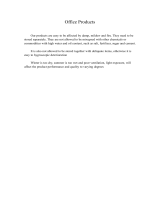
20 OPERATION
Food Storage Guide
Food Storage Tips
Storing Vegetables and Fruit
•
The moisture left on vegetables after washing can
make them spoil faster. Wait to wash vegetables
until just before use.
•
Leafy greens like kale or lettuce have a limited
storage life. Wrap them in newspaper or in sealed
containers to help them stay fresh longer.
•
Do not store tropical fruits in the refrigerator.
•
Bananas or uncut pineapples are damaged by cold
temperatures.
Kimchi Storage Tips
Do not overfill the kimchi containers.
•
Allow space for the kimchi to expand as it ferments
or the contents may overow the container. Close
the container lids completely to prevent the kimchi
from fermenting too quickly or developing yeast
mold. Fill the container with kimchi up to the ll line
and make sure the lid is tightly closed before
storing. Cover the surface of the kimchi with plastic
wrap to extend the storage time.
Do not place kimchi directly into the refrigerator
compartment or store it in a plastic bag.
•
Use the kimchi container provided to store kimchi.
Kimchi placed directly into the refrigerator
compartment may freeze and taste off. Do not block
the air outlet inside the refrigerator with food. Doing
so could cause the food to freeze, affect product
performance, or result in electric shock or injury.
For best results, check on kimchi within 3 to 4
days of storing it.
•
If the kimchi has overowed from the container, it
may ferment too quickly and not store well.
Be sure to use enough salt when preparing kimchi
for longer storage.
•
The rate of fermentation is mostly determined by the
amount of salt in the kimchi. Small batches of mild
kimchi can be successfully stored for short periods,
but add more salt if storing large amounts for use
over an extended period.
Use care when placing kimchi containers in the
refrigerator.
•
Lift the container by the handles and avoid impacts
to the bottom of the container.
(The appearance of kimchi containers may vary by
model.)
Do not place foods that require different storage
conditions in the same compartment.
•
Select the appropriate settings for the food being
stored.
A Guide to Kimchi
The first step in fermenting kimchi is salt pickling.
•
The salt reacts with enzymes in the cabbage to
break down proteins and begin fermentation
immediately. This process continues even at cold
temperatures. Traditionally, kimchi was allowed to
ferment slowly during the cold winter weather.
The taste of kimchi also depends on the
seasonings used.
•
Typical seasonings include green onion, garlic, ginger,
salted sh, and chili powder. The combination of spices
chosen determines the overall taste of the kimchi.
Fermentation Rates for Kimchi
•
Adding a lot of garlic, seafood, onions, chili powder,
cucumber or green onions makes kimchi ferment
more quickly. Adding salted oysters, salted shrimp
or persimmon sauce really speeds up fermentation.
On the other hand, adding leeks, mustard or
ginseng slows down fermentation.
Kimchi begins fermenting as soon as it is prepared.
•
Contact with air will make kimchi sour. If the kimchi
is not covered in sauce or has too little salt, a thin
skin of yeast will form on its surface. Keep air away
from the vegetables by covering them in sauce or
placing the kimchi in a plastic bag or covering it with
plastic wrap.
How Temperature Affects Kimchi
•
Temperature affects the fermentation rate of kimchi.
When preparing kimchi for long-term storage, keep
the temperature below 50°F (10°C).
Long-Term Storage of Kimchi
•
Like cheese, kimchi is a living organism and will
change over time. To keep kimchi fresh for long
periods, increase the salt content and store at a low
temperature, near 32°F (0°C). Press vegetables
down so they are covered with sauce and cover the
container with plastic wrap or a layer of cabbage
leaves to keep air out and keep kimchi fresh longer.
Choosing the Right Cabbage for Kimchi
•
There are many different kinds of cabbage available.
For kimchi, choose a medium sized cabbage which
is rounded rather than long and thin. The inner
leaves should be sweet and paler than the outer
leaves. Outer leaves should be thin and light green.
Selecting Radishes for Kimchi
•
There are many types of radish kimchi, and different
radishes are used for different types of kimchi.
•
For radish kimchi, use Korean radishes that have
pale green tops and well-spread leaves.
•
For chonggak (young radish) kimchi, use Seoul
radishes that have round, thick bottoms.
•
For kkakdugi (cubed radish kimchi), try to nd
radishes with white rather than green tops.
•
For dongchimi, use radishes with soft leaves and
white rather than green tops.




















